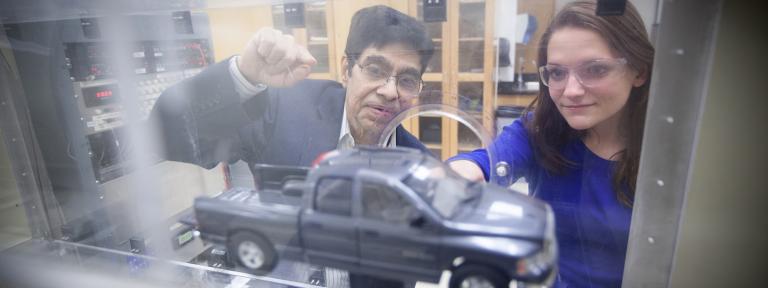
For Dr. Birendra Pandey, predicting the weather on another planet is a lot easier than predicting the weather here on earth. "There is no one there to check your prediction," he said. "It's always better to predict things that cannot be verified."
Pandey is Kettering University's first post doctorate research fellow and something of a space weather expert. As an astrophysicist studying what has been labeled space weather, he has researched how solar disturbances affect weather on earth.
"Disturbances like solar wind, or hot plasma, hit the earth's magnetosphere which in turn affects the ionosphere and that affects all our weather on earth," he said. Learning more about space weather may help answer questions about the earth's damaged ozone layer and improve understanding of the sun's importance to earth.
His passion for the topic is infectious. Recent photos from the Hubble Space Telescope showing the collision of two galaxies leave him marveling at the enormity of it all. "These events are 2,000 light years away," he said, "we are looking back 2,000 years. It is like looking at the beginning of the whole story."
Putting cosmic weather prediction aside, Pandey's work at Kettering involves mathematical modeling for the electrostatic propulsion of hall thrusters and the investigation of dusty plasma dynamics. Hall thruster technology, key to inter-planetary space missions, is what makes satellites maneuver through space, and dusty plasma is a mixture or partially ionized gas containing impurities that can cause "interesting effects," according to Pandey.
Pandey and Dr. K. Joel Berry and Dr. Subrata Roy are researching ways to improve the performance of hall thrusters in the Computational Plasma Dynamics Laboratory (CPDL), the first dedicated space-related research environment at Kettering. Berry is department head for Mechanical Engineering at Kettering and Roy is assistant professor of Mechanical Engineering and director of the CPDL.
Hall thrusters are currently not efficient in the way plasma interacts with propellant. "The simulations we're doing in the lab are based on the same fundamental principles as those involved in the formation of the galaxy," said Pandey. "We can look at our findings related to the dynamics of plasma and apply them to broader subjects."
He relates this research to the quest for new sources of energy. "We are trying to understand how the sun was formed so we can replicate that process here on earth, or what we call fusion research," said Pandey. "The ultimate goal is to be able to pump out an almost infinite amount of energy by fusing two helium atoms. However, confining the million-degree hot plasma for long durations is not easy."
Various forms of funding for the research comes from NASA's Glenn Research Center for On-Board Propulsion, the Air Force Office of Scientific Research (AFOSR), the National Science Foundation (NSF), and the National Partnership for Advanced Computational Infrastructure (NPACI).
Pandey's love affair with the stars can be blamed on his father, who in 1969 woke him at 3 a.m. to see the comet Kohutek from their home in Samastipur, India. From there he went to Moscow at the age of 18 to study mathematics at the People's Friendship University.
"I came to astrophysics partly by chance and partly due to my professor at the Physical Research Laboratory, Dr. R.K. Varma," he said. "I wanted to study particle physics because it is truly the frontier of the subject, where you ask questions about the most basic materials of life." To that end he studied theoretical physics.
His experiences during his seven years in Russia helped cement his passion and developed his work ethic. "We were taught in the style of classic European learning," he said. "Our teachers were idealists, willing to answer questions in the middle of the night, they were devoted and selfless. They are the models I aspire to," said Pandey.
In addition to the influence of his teachers, Pandey fell under the tutelage of his fellow students. With students from all over the world, there was a rich diversity of ideologies and cultures. "It helped me broaden in my horizons," he said.
"We lived in a hostel setting with four to a room," said Pandey, "complete with a Russian comrade in every room for our political education. As young people you are going to eventually question each other's ideologies and beliefs. It was a rich and rewarding learning environment," he said.
After completing the seven-year course and earning the equivalent of a bachelor's and master's degree, Pandey returned to India to work at the Physical Research Laboratory as a research scholar. He was one of four students selected for the position out of 600. "My father was very encouraging," Pandey said, "I wanted to get a job and he encouraged me to stick with research."
During his six years at the Physical Research Laboratory, Pandey worked under R. K. Varma, who "never allowed me to do things that were half hearted. He influenced my philosophy of life as much as my Russian teachers," said Pandey. "I was lucky to have them all just at the time I needed them," he added.
Upon finishing his Ph.D. he worked for the Indian Institute for Geomagnetism researching the magnetosphere of earth, general plasma and astrophysics. Then he went to Belgium to the Center for Plasma Astrophysics before settling at Kettering in August of 2001 as its first post doctorate research fellow.
"I came to the United States because of the advantages available here for research," he said.
Pandey has been married to wife Arti, a secondary school chemistry teacher, since 1985, they have a 10-year old son, Priyadarshi.
Written by Dawn Hibbard
(810) 762-9865
dhibbard@kettering.edu